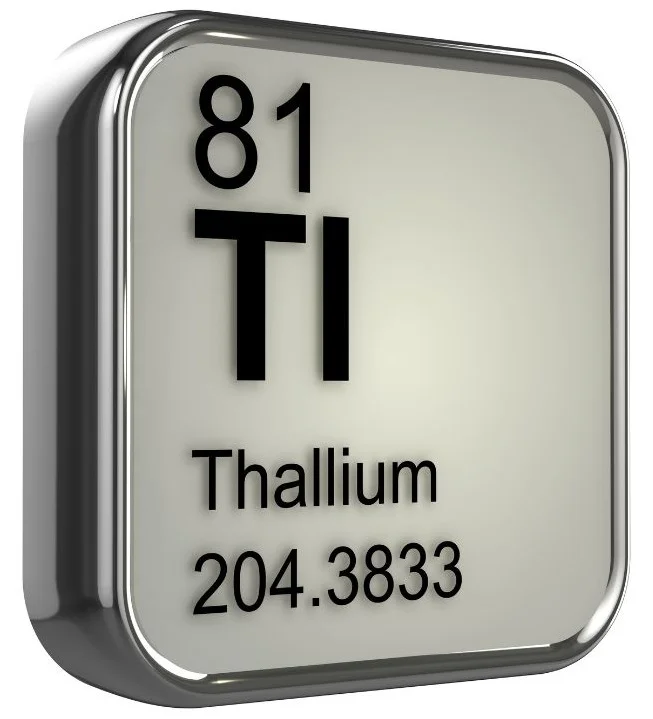Thallium Metallicum (Thallium) is a homeopathic remedy primarily known for its profound effects on the nervous system, musculature, and skin.
It is often indicated for severe neuralgic pain, muscular atrophy, paralysis, and conditions such as alopecia following debilitating illnesses.
This remedy is particularly useful for treating the violent pains of locomotor ataxia, polyneuritis, and chronic neurological disorders.
In homeopathy, it addresses disorders that involve sharp, shooting pains and physical weakness, often resembling electric shocks.

SOURCE INFORMATION
Scientific Classification
- Kingdom: Mineral
- Element: Thallium
- Symbol: Tl
- Atomic Number: 81
- Element Category: Post-transition metal
Origin and Historical Facts
- Thallium is a chemical element discovered by Sir William Crookes in 1861 while investigating spectral lines of selenium.
- The name Thallium comes from the Greek word “thallos,” meaning “a green shoot,” referring to its bright green spectral emission lines.
- It was initially used industrially for electronics and optics and later became recognized for its toxic effects, especially its impact on the nervous system and hair loss (alopecia).
- The homeopathic use of Thallium derives from its toxicology, where small, potentized doses are used to treat symptoms such as neuralgia, muscular degeneration, and paralysis, conditions reminiscent of its poisonous effects.
DRUG PATHOGENESIS
- The drug pathogenesis of Thallium Metallicum revolves around its powerful effects on the nervous system and musculature.
- It is known to cause neuralgia, muscle atrophy, and paralysis, with symptoms such as sharp, shooting pains and electric shock sensations throughout the body.
- It also influences the endocrine glands, especially the thyroid and adrenal glands, causing hormonal imbalances and associated symptoms like night sweats, alopecia, and exhaustion.
PHYSICAL CONSTITUTION, DIATHESIS, AND TEMPERAMENTS
- Physical Constitution: Thallium suits individuals suffering from progressive physical weakness, trembling, and loss of muscular strength, especially in the lower limbs.
- Diathesis: It is useful for individuals prone to degenerative neurological conditions, muscular atrophy, or alopecia after acute diseases.
- Temperament: The patient is often irritable and feels overwhelmed by pain and physical weakness. There may be emotional disturbances due to their physical incapacity.
KEY CHARACTERISTICS
- Neuralgia: Excruciating, spasmodic, shooting pains resembling electric shocks.
- Muscle Atrophy: Progressive wasting of muscle tissues, especially in the lower limbs, leading to paralysis.
- Alopecia: Hair loss following acute, exhausting diseases.
- Polyneuritis: Inflammation of multiple nerves, resulting in weakness, numbness, and pain, especially in the extremities.
DETAILED ORGAN SYMPTOMS
NERVOUS SYSTEM
- Severe Neuralgic Pain: Sharp, shooting pains, often compared to electric shocks, are characteristic.
- Polyneuritis: Pain and inflammation of multiple nerves, particularly affecting the extremities and leading to numbness.
- Chronic Myelitis: Inflammation of the spinal cord, leading to paralysis and loss of sensation.
- Tremors and Weakness: Constant trembling of the limbs, with muscular fatigue.
MUSCULOSKELETAL SYSTEM
- Muscular Atrophy: Progressive wasting of muscles, particularly in the lower limbs, leading to paraplegia (paralysis of the lower half of the body).
- Paralysis: Especially of the lower limbs, with a sense of numbness and weakness extending from the toes upward.
- Electric Shock-like Pains: Pain in the muscles and joints, particularly in the arms and legs, is often described as electric shocks.
SKIN AND HAIR
- Alopecia: Sudden and rapid hair loss, especially after acute or exhausting illnesses.
- Trophic Skin Lesions: Skin ulcers or sores caused by nerve damage, particularly in the extremities.
DIGESTIVE SYSTEM
- Stomach and Bowels: Severe, electric shock-like pains in the stomach and bowels, often accompanied by nausea.
EXTREMITIES
- Numbness and Formication: A sensation of crawling or tingling, starting from the fingers and toes and extending through the pelvis and perineum to the lower abdomen.
- Cyanosis: A bluish discoloration of the skin, particularly in the extremities, due to poor circulation.
MODALITIES
- Worse: From cold, lying down, rest, and at night.
- Better: From warmth and movement.
WHAT ARE MODALITIES IN HOMOEOPATHY?
RELATIONSHIP WITH OTHER DRUGS
Compare with:
- Lathyrus sativus: For paralysis and muscular atrophy, particularly of the lower limbs.
- Causticum: For neuralgia, paralysis, and spasms.
- Argentum Nitricum: For progressive weakness and ataxia.
- Plumbum metallicum: For muscular atrophy, paralysis, and severe neuralgic pain.
DOSAGE
- Prescribed in low triturations up to the thirtieth potency.
- The choice of potency depends on the intensity of the symptoms and the patient’s overall condition.
Frequently Asked Questions
What is Thallium Metallicum used for?
- It is used in homeopathy for treating severe neuralgic pain, paralysis, muscular atrophy, polyneuritis, and alopecia, particularly following acute diseases.
Can Thallium Metallicum treat hair loss?
- Yes, it is often prescribed for alopecia, particularly when hair loss occurs after severe or exhausting illnesses.
How does Thallium Metallicum affect the nervous system?
- It causes neuralgic pain, muscle tremors, numbness, and eventually paralysis, particularly affecting the lower limbs.
Is Thallium Metallicum safe?
- Yes, when used in potentized homeopathic doses, Thallium Metallicum is safe. However, in its raw form, Thallium is toxic.
What potency is recommended for severe neuralgic pain?
- Low potencies (up to the thirtieth potency) are commonly recommended, but the potency can vary based on individual symptoms.
Glossary of Difficult Words
- Neuralgia: Severe pain along a nerve, often with a sharp, shooting character.
- Paraplegia: Paralysis of the lower half of the body, typically affecting both legs.
- Polyneuritis: Inflammation of multiple nerves, leading to pain, numbness, and weakness.
- Myelitis: Inflammation of the spinal cord, often leading to paralysis.
- Alopecia: Loss of hair, especially from the scalp.
- Formication: A sensation like insects crawling on or under the skin.
- Cyanosis: A bluish discoloration of the skin caused by poor blood circulation or inadequate oxygenation of the blood.
- Trophic Lesions: Skin ulcers or sores caused by poor nerve function.
